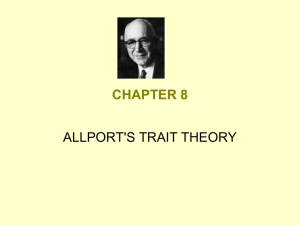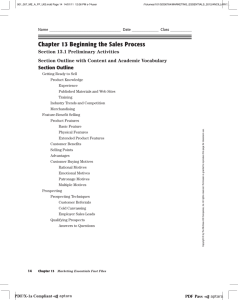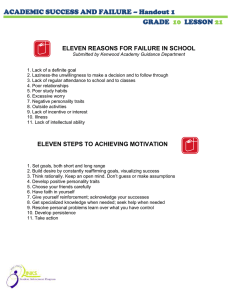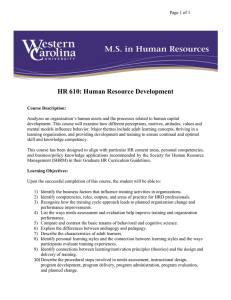Linking Female Leaders’ Personality Traits to Motives, Powers
advertisement
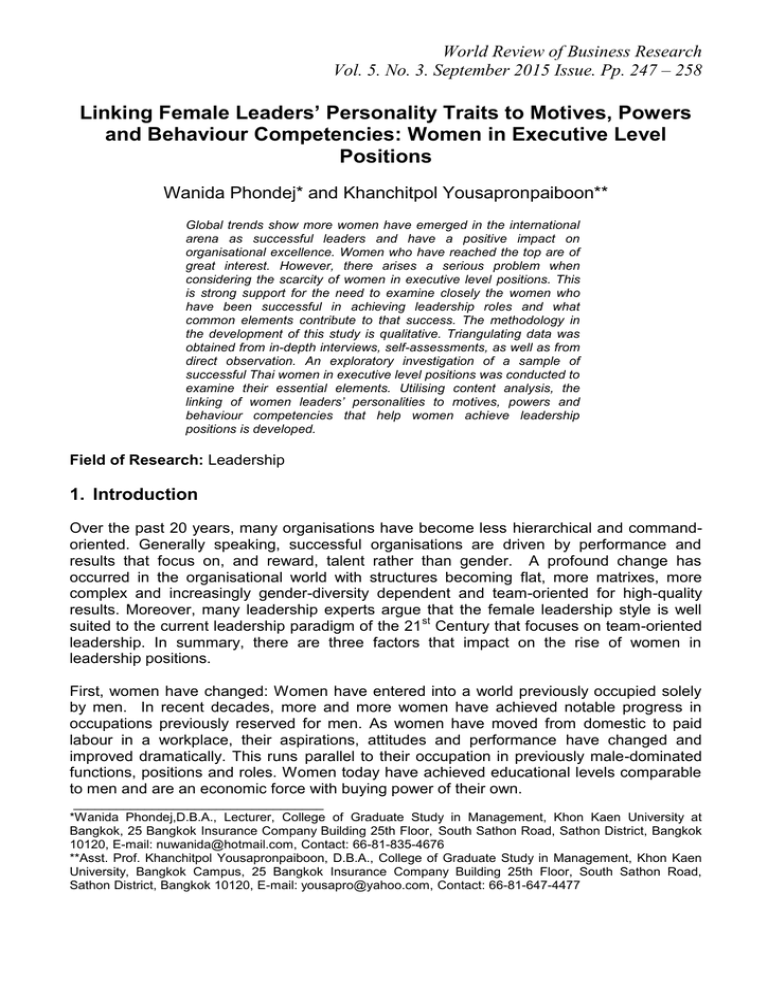
World Review of Business Research Vol. 5. No. 3. September 2015 Issue. Pp. 247 – 258 Linking Female Leaders’ Personality Traits to Motives, Powers and Behaviour Competencies: Women in Executive Level Positions Wanida Phondej* and Khanchitpol Yousapronpaiboon** Global trends show more women have emerged in the international arena as successful leaders and have a positive impact on organisational excellence. Women who have reached the top are of great interest. However, there arises a serious problem when considering the scarcity of women in executive level positions. This is strong support for the need to examine closely the women who have been successful in achieving leadership roles and what common elements contribute to that success. The methodology in the development of this study is qualitative. Triangulating data was obtained from in-depth interviews, self-assessments, as well as from direct observation. An exploratory investigation of a sample of successful Thai women in executive level positions was conducted to examine their essential elements. Utilising content analysis, the linking of women leaders’ personalities to motives, powers and behaviour competencies that help women achieve leadership positions is developed. Field of Research: Leadership 1. Introduction Over the past 20 years, many organisations have become less hierarchical and commandoriented. Generally speaking, successful organisations are driven by performance and results that focus on, and reward, talent rather than gender. A profound change has occurred in the organisational world with structures becoming flat, more matrixes, more complex and increasingly gender-diversity dependent and team-oriented for high-quality results. Moreover, many leadership experts argue that the female leadership style is well suited to the current leadership paradigm of the 21 st Century that focuses on team-oriented leadership. In summary, there are three factors that impact on the rise of women in leadership positions. First, women have changed: Women have entered into a world previously occupied solely by men. In recent decades, more and more women have achieved notable progress in occupations previously reserved for men. As women have moved from domestic to paid labour in a workplace, their aspirations, attitudes and performance have changed and improved dramatically. This runs parallel to their occupation in previously male-dominated functions, positions and roles. Women today have achieved educational levels comparable to men and are an economic force with buying power of their own. ___________________________________ *Wanida Phondej,D.B.A., Lecturer, College of Graduate Study in Management, Khon Kaen University at Bangkok, 25 Bangkok Insurance Company Building 25th Floor, South Sathon Road, Sathon District, Bangkok 10120, E-mail: nuwanida@hotmail.com, Contact: 66-81-835-4676 **Asst. Prof. Khanchitpol Yousapronpaiboon, D.B.A., College of Graduate Study in Management, Khon Kaen University, Bangkok Campus, 25 Bangkok Insurance Company Building 25th Floor, South Sathon Road, Sathon District, Bangkok 10120, E-mail: yousapro@yahoo.com, Contact: 66-81-647-4477 Phondej & Yousapronpaiboon Second, leadership roles have changed: Nowadays, leadership is no longer based on control, coercion and disempowerment but on inspiration, facilitation and empowerment (Eisler, 2005). In view of changes in leadership roles, female leaders have come to symbolise a new type of leadership that connotes greater effectiveness and synergy than leadership of the past (Adler, 2001). Women seem ideally suited to the new leadership roles. It is clear that women are taking on leadership roles in greater numbers than ever before. Third, the world has changed. The world is getting smaller, faster and flatter and offers unlimited opportunities. Today women have more voice but also face more challenges than ever before. Many organisations support women by encouraging mentoring and coaching and establishing a more women-friendly workplace. Under these conditions, gender-fair organisations substantially enlarge the pool of talent from which to select their managers, and, for many managerial roles, the selection of women can increase organisations‟ chances of obtaining leaders who are especially effective under modern conditions (McCracken, 2000). Global trends show more and more women have emerged in the international arena as successful leaders both in business and political circles. These female leaders demonstrate leadership abilities on a par with male leaders. They can successfully perform as a CEO, President, or Prime Minister. This means that effective women‟s full participation in leadership can improve outcomes. Deficiencies in the literature give rise to the following problem “How do talented women lead‟? The hidden reasons explaining how female leaders reach the top are quite fascinating. This paper specifically focuses on essential elements such as personality traits, motives, powers and behaviour competencies of women in executive level positions. This study has been conducted on successful Thai women in executive level positions. The objectives of this paper are: a. To identify the personality traits, motives, powers and behaviour competencies of successful women in executive level positions. b. To study how personality traits, motives, powers and behaviour competencies of women in executive level positions link together. This paper is organised as follows: literature review is presented in the following section and this is followed by a brief introduction to the research methodology. Research findings and outcomes is then presented. The final section contains concluding remarks, interpreting their implications, and discussing limitations and possibilities for further research. 2. Literature Review This literature review shows a connection between the disciplines; Women in executive level positions, leadership traits, motives, powers and behaviour competencies. 2.1 Women in Executive Level Positions Female leadership has gained significant attention in leadership research. Despite the scarcity of role models and various socio-cultural and organisational obstacles some women 248 Phondej & Yousapronpaiboon do emerge as leaders. Documenting the important contributions of women leaders will enhance opportunities to create more women leaders in the future (Phondej, et al., 2010). A 2007 McKinsey study found that companies in Europe, America and Asia with 30% or more women in their senior management teams achieve higher average scores for “organisational excellence”. Numerous books and studies tell powerful stories about effective female leaders making a positive impact on organisational excellence, improved outputs and higher profit margins. Female leaders have utilised transformational ways of leading, in which empowerment and the commitment of employees is more congruent and advantageous to the female. Such a style includes the act of reward of achievements and reached goals and the correction of failures (Eagly, 2003). There are many studies showing that the unique themes for female leaders are inspiring commitment, self-development ability and enlightening communication. This makes female leadership style often more motivating and inspirational and which centres on and is positive around communication working relationships (Werhane, 2007). 2.2 Personality Traits In this paper, personality traits are defined as inborn talent or early-life experiences that promote a consistent pattern of leadership performance across a variety of group and organisational situations (Antonakis, et al., 2004). Personality traits are hidden and difficult to change. The Five-Factor Model of personality categorises traits typically referred to by the five letters O, C, E, A, and N. O refers to openness to new experiences, C refers to conscientiousness, E refers to one‟s “extraversion.”, A refers to agreeableness and N refers to negative emotionality. The natural leader defined in Five-Factor Model terms is visionary (O+); dedicated to a goal (C+); energetic, outgoing and persuasive (E+); competitive (A-); and resilient (N-) (Howard & Howard, 2001). Some people have an easier time developing their leadership skills than others. Most agree that certain personality types make better leaders. Human personality may be important factors in discovering the characteristics of successful female leaders. So the real question is: what are these leadership personality traits. 2.3 Motives Motives are the internal factors that affect behaviours. The word motive is derived from the Latin motivus, meaning "to move". McClelland„s trait theories of Achievement Motivation Theory attempts to explain and predict behaviour and performance based a person‟s need for achievement, power, and affiliation (Lussier & Achua, 2007). The Leader Motive Profile (LMP) that has been found to be a reliable predictor of leader effectiveness includes a high Power Motive, which is Socialised Power that is greater than the Affiliation Motive and with a moderate Achievement Motive. The achievement score is usually somewhere between the power and affiliation score. Socialised Power is not included in the motive profile. Effective leaders use Socialised Power with includes the traits of sensitivity to others and stability (Lussier & Achua, 2007). 249 Phondej & Yousapronpaiboon Knowing a female leader‟s motive profile is useful, since it can explain and predict behaviour, performance and success based on a person‟s need for achievement, power and their affiliation motive profile. 2.4 Power To lead means to use power to influence others (De Wit & Meyer, 2004). Power refers to the means leaders have to potentially influence others. Thus, the ability to lead others requires that one has power because power and influence play such important roles in the leadership process (Hughes, et al., 2006). Leaders can derive their potential influence from two general sources: their position and their person. The power of position comes from a leader„s formal function in the organisation. Personal power is rooted in the specific character, knowledge, skills and relationships of leaders. Managers always have some level of positional power, but they do not necessarily have the personal power needed to get organisational members to follow them (Antonakis, et al., 2004). Female leaders act more on behalf of the public good, but enthusiasm about this generalization would depend on one‟s political stance (Eagly, 2003). Women‟s empathy and insight is receiving boardroom attention as companies realize that in an ever‐globalising world these skills are necessary (Boon, 2003). 2.5 Behaviour Competencies Leadership competencies associated with leadership effectiveness. Current trends indicate identifying competencies is valuable in understanding the leadership development puzzle (Yamazaki & Kayes, 2004). Many scholars define competency as an underlying characteristic of an individual that is related to superior performance. Leadership competencies have been defined from the point of view of behaviour competency. The linking between competency and leadership also illustrates the leadership competency model. Leadership competencies are those most likely to be changed through leadership development efforts and managerial experience. For example, transactional competencies decrease and transformational competencies increase with increases in the level of managerial experience (Bartram, 2009). 2.6 Conceptual Framework While much research has been published comparing the leadership styles of women and men, “limiting” factors for females have been found in the environment area. Discussions of the gap in the literature of areas lacking research such as a connection between leadership traits, motives, powers and behaviour competencies of female leaders will be revealed. It will be important to establish how the combination of leadership traits, motives, powers and behaviour competencies can provide the background as being essential elements that empower women to perform at an executive level. It is likely that all perspectives provide value and complement each other by helping to understand women in executive level positions. 250 Phondej & Yousapronpaiboon This study proposes an expanded conceptual framework of female leaders‟ essentials elements as shown in Figure 1. In this expanded framework, the configuration of personality traits should be linked to motives, powers and behaviour competencies. Figure 1: Conceptual Framework Motive Personality Traits •O: Openness to new experiences •C: Conscientiousness •E: Extroversion •A: Agreeableness •N: Negative emotionality •Achievement Motive •Power Motive •Affiliation Motive •Socialised Power motive Power •Position Power •Personal Power Behaviour Competencies 3. Methodology Due to the lack of prior research on the essential elements of women in executive level, the goal of this study is inductive theory building rather than theory testing. This study concerns the theme of leadership which is a complex concept and an embedded phenomenon. Thus the relative freedom to explore the potential outcomes of qualitative research can provide insightful outcomes. An exploratory investigation of a sample of 40 successful Thai women in executive level in both the private sector and public sector was conducted to examine their essential elements from July to September 2009. Triangulation played an important role in the data collection and data analysis for this research was necessary to ensure a vigorous and diverse collection of information. Data collection was based on multiple sources of evidence. In-depth interviews, personality selfassessment, competency self-assessment and observation were conducted for examining participants‟ personality traits, motives, powers and behaviour competencies. 4. Findings and Outcomes The study finding and outcome derived from data analysis consists of examining, categorising, tabulating, testing, and recombining both quantitative and qualitative evidence to address the initial propositions. Three specific analytic techniques were used: patternmatching, explanation building and cross case synthesis. The most interesting and important finding in the study is that women in executive level share the same personality traits and links to their motives, powers and behaviour competencies. This is illustrated in Table 1. 251 Phondej & Yousapronpaiboon Table 1: Linking Female Leaders’ Personality Traits to Motives, Powers and Behaviour Competencies Five-Factor Model (O+) Personality traits Explorer High Openness to new experience (C+) Focused Ambivert Moderate Extraversion (A=) Include with other motive Expert Power Behaviour Competencies SelfDevelopment: High Achievement Motive Expert Power Low Power Motive Socialised Power Results Oriented: Achievement Orientation and Initiative Team leadership: Respect & Sincere Negotiator Moderate Agreeableness (N-) Personal Power Expertise and Information Seeking High Consciousness (E=) Motive Moderate Affiliation Motive Socialised Power Developing Others: Inspiring and Kindness Resilient Low Negative Emotion High Socialised Power Motive Socialised Power Self-Awareness: self-control and integrity. 4.1 The Personality Traits of Women in Executive Level Positions The results of the women in executive level positions self assessing their own personality traits, was verified by interviewing participants to describe their real life histories at sufficient levels of detail. The profile showed certain talents improve women‟s chances for leadership. The personality traits of female leaders defined in Five-Factor Model terms is O+, C+, E= ,A=, and N-. Table 2: The description of personality traits of women in executive level Five-Factor Model O+ Personality traits Explorer Description curious, dreamer and visionary C+ Focused organized, perfectionist, ambitious E= Ambivert enjoys a balance of solitude and sociability A= Negotiator comfortable holding out for the win-win situation N- Resilient content, controlled, secure, stress-free O+ (High Openness to new experience): Explorer Women in executive level positions are strong in Openness (O+). They seek change and trying new things. Their general talent is “creative”, tend to have many broad interests and like to be at the cutting-edge or forefront in creativity, resourcefulness, taking some risks and able to imagine the future of an organisation. They may espouse a vision as strategic 252 Phondej & Yousapronpaiboon thinker, but they can be practical and efficient so that people don‟t think them out of touch with reality. C+ (High Conscientiousness): Focused The Conscientiousness personality factor is related to achievement. The result shows women in executive level positions to be high conscientiousness (C+) leaders. They are commonly “Focused” on the goal, responsible and persistent, are likely to plan for the monitoring and follow-up necessary to bring a project to a successful conclusion. However, they must occasionally be spontaneous and playful. E= (Moderated Extroversion): Ambivert The Extroversion personality factor is on a continuum between extravert and introvert. Women in executive level positions are generally moderate Extrovert (E=), have a balance of extrovert and introvert features, enjoy time with others but also time alone. They have the capacity to moderate their extrovert / introvert according to situation, tend to move easily from working with others to working alone. A= (Moderated Agreeableness): Negotiator The Agreeableness personality factor relates to getting along with people. Women in executive level positions display moderate agreeableness (A=). They are good at adopting win-win approaches, sufficiently tough, but also able to show understanding of others‟ needs and interests. They can shift between competitive and cooperative situations. In addition to being able to say “Yes”, when required they are equally capable of saying “No”. N- (Low Neuroticism): Resilient The Neuroticism personality factor relates to emotional stability. Women in executive level positions achieve low scores in Neuroticism (N-), they are confident and generally less easily upset and are less emotionally reactive. They tend to be calm, emotionally stable, and free from persistent negative feelings. This does not mean that they possess a good deal of positive feelings; frequency of positive emotions is a component of the Extroversion factor. Recent studies support the relationship between the Five-Factor Model and successful leadership. The ideal type of natural leader defined in the Five-Factor Model terms is high Openness to new experience (O+: Explorer); high Consciousness (C+: Focused); high Extravert (E+: Extravert); low Agreeableness (A-: Challenger); and low Negative Emotionality (N-: Resilient) (Howard & Howard, 2001). The personality traits of women in executive level positions are not perfectly matched with an ideal type of leadership profile. The result showed only three traits, (1) high Openness to new experience (O+: Explorer); (2) high Consciousness (C+: Focused); and (3) low Negative Emotionality (N-: Resilient) that match the ideal type. There are two traits that are off target: (1) moderate Extravert (E=: Ambivert); and (2) moderate Agreeableness (A=: Negotiator). 4.2 The Motives of Women in Executive Level The research finding showed women at executive levels possessed high achievement motives, low power motives, high socialised power and moderate affiliation motives that are illustrated in Figure 2 253 Phondej & Yousapronpaiboon Figure 2: The Motive Profile of women in executive level High Achievement Motive •Concern for excellence in accomplishmen ts through individual efforts. Low Power Motive High Socialised Power •Concern for influencing others and seeking positions of authority •Concern for achieveing goals and bring the best out of people and the organisation. Moderate Affiliation Motive •Concern for developing, maintaining, and restoring close personal relationships. High Achievement Motive The achievement motive (need for achievement: n-ach) is the unconscious concern for excellence in accomplishment through individual effort (Lussier & Achua, 2007). The data analysis showed women in executive level positions had high achievement motives and focussed on both individual and organisational achievement. People with a high achievement motive think about ways to do a better job, how to accomplish something unusual or important and foster career progression. This means that they tend to have openness to new experience, self-confidence, and high energy. They are goal oriented, seek challenge, strive for excellence, desire concrete feedback on their performance and work hard. Low Power Motive The power motive (need for power: n-pow) is defined as a desire for strong action such as to attack, support, advise or control others, and influence others‟ emotions (McClelland, 1985). Power is essential to leaders because it is means of influencing followers. Without power, there is no leadership. Women in executive level positions in this study had low power motives. Data analysis found that 75% of participant in the private sector and 50% of participants in the public sector never applied for senior positions. This means that they view power in terms of influence, not position. They tend to direct their power motives at influencing others for the common good. They are not concerned about the position or for power that motivates them to seeking the highest leadership positions. High Socialised Power Women in executive level positions are trying to find balance in their lives and need socialised power to help themselves and others. Socialised power (need for Socialised power: n-soc pow) can be used for personal gain and at the expense of others (McClelland, 1985). They value power as instrumental in benefiting the organisation and meeting the needs of others, and is used to achieve goals and to bring out the best in people and the organisation. Moderate Affiliation Motive The affiliation motive (need for affiliation: n-aff) is the unconscious concern for developing, maintaining, and restoring close personal relationships (Lussier & Achua, 2007). The data analysis showed women in executive level positions had moderate affiliation motives and focus on their family and social affairs rather than focus only on business objectives. They help employees to feel as comfortable at work as at home. However, they did not show too close a relationship with others, and did not enjoy a munificence of social activities. They tend to enjoy developing and helping others. 254 Phondej & Yousapronpaiboon The Leaders Motive Profile includes a moderate Achievement Motive, high Power Motive, high Socialised Power and moderate Affiliation Motive (Lussier & Achua, 2007). The motives of women in executive level positions have been found not to be a perfect match with the Leader Motive Profile. The result showed two motives, High Socialised Power and Moderate Affiliation Motive that match the ideal type. There are two motives that are off target, Achievement and Power Motives. Leaders generally need to have a moderate Achievement Motive. While women in executive level positions are people with high achiever motives, they tend to seek individual achievement. Leaders need to have a high Power Motive to influence others (Lussier & Achua, 2007). In contrast, women in executive level have low Power Motives. 4.3 The Powers of Women in Executive Level Positions Power and leadership are related because both involve a process of influence. In organisations, power can be distinguished between positional power and personal power. According to data analysis, women in executive level positions utilised their personal power to reach their leadership positions. They don„t want the power of their positions for its own sake, only to get what they want. Personal power is the key power that they used as their actual power. Personal power is rooted in the specific character, knowledge, skills and relationship of leaders (Antonakis, et al., 2004). In this study the personal power is rooted in the expert power and socialised power. Expert Power Women in executive level positions use work performance as expert power to make people respect them, not just as bosses. They make others respect that they have more supplementary knowledge and skill. Expert power is based on their skill and knowledge. Being an expert makes others depend on them and provides respect where there are few who possess expertise and this provides more power to be a leader. Experts commonly use the rational persuasion influencing tactic, because people believe they know what they are saying is correct. Socialised Power Socialised Power is exercised in serving higher goals to others, or organisations, and often involves self-sacrifice to achieve those ends (Hughes, et al., 2006). Women in executive level positions rely on power arising from relationships and a desire for followers to be led. They utilise relationship behaviours to motivate and inspire people. They focus on the performance of group members, helping them see the importance and higher good of the task that create the synergy that drives organisations. They want each person to fulfil their potential and do a better job. 4.4 The Behaviour Competencies of Women In Executive Level Positions Through Competency Self-Assessments and in-depth interviews, behaviour competencies of women in executive level positions can be categorized into five different subsets that are self-awareness, self-development, result oriented, team leadership and people development. (1) Self-Awareness: Knowing one's internal states, preferences, resources and intuitions by self-control and integrity. 255 Phondej & Yousapronpaiboon a. Self-Control: the ability to keep emotions under control and to restrain negative actions when tempted or faced with opposition or hostility from others, or when working under conditions of stress. b. Integrity: The behaviour that is honest and ethical, making a person trustworthy. (2) Self-Development: Seeking opportunities to learn and to develop themselves; applies new skills/knowledge by expertise and information seeking behaviour competencies. a. Expertise: The mastery of a body of job-related knowledge, and also the motivation to expand, use, and distribute work-related knowledge to others. b. Information Seeking: An underlying curiosity, a desire to know more about things, people, or issues beyond that required in the job. (3) Results Oriented: Focusing personal efforts on achieving results consistent with the organization's objectives by achievement orientation and initiative behaviour competencies. a. Achievement Orientation: A concern for working well or for competing against a standard of excellence. b. Initiative: Doing more than is required or expected in their jobs, doing things that no one has requested to improve or enhance job results and avoid problems, or finding or creating new opportunities. (4) Team leadership: Effectively managing and guiding group efforts. This includes providing the appropriate level of feedback concerning group progress by respect and sincere behaviour competencies. a. Respect: Provide trust, respect to people, and believe in power. Listening to staff‟s opinions and accept constructive criticism, looking for strengths in people and appreciate them. b. Sincere: Strong direct relationships with others, speak truly about their own feelings, thoughts, and desires, and won‟t lie to people. (5) Developing Others: Willing to delegate responsibility, work with others, and coach them to develop their capabilities by Inspiring and kindness behaviour competencies. a. Inspiring: Focus on the positive aspects of follower‟s skills and personality and use that as a motivating force and find ways to help them do it better. b. Kindness: Recognise unique talents while nurturing all employees and establish a supportive and productive work environment. 5. Conclusion Female leaders in this study have a high Openness to new experience (O+) related to all motives; then related to expert power and finally related to self-development competency behaviour. They also have a high Conscientiousness personality (C+) that is related to a high Achievement Motive; that is related to expert power and associated to results oriented competency behaviour. Furthermore, they have a moderate Extraversion (E=) that is related to low on the power motive. At the same time, they use socialised power to 256 Phondej & Yousapronpaiboon influence others as team leadership by gaining respect of others and by their sincerity. They have moderate Agreeableness (A=) that is related to moderate affiliation motive then use socialised power for developing others by inspiring and kindness. Lastly, they have a low Negative emotion (N-) related to high Socialised Power Motive. This helps them have socialised power indicating self-awareness. As a result, female leaders‟ personalities and motives affect the ways they attempt to influence others using their personal power that are related to their competency behaviours. The results are not a perfect match with the ideal type of general leadership profile in earlier studies. The research findings provide insights to corporations based in Thailand about how to develop women in executive level positions. The implications of these findings should contribute to an appreciation of how talented women build their own development, improve their self-knowledge and discover personal qualities that support their work as leaders. Future research should develop and obtain data on women in executive level positions in other countries and conduct some quantitative research. The limitations of this study include the capacity to generalise the study. There were only 40 participants who were Thai women at executive levels in the complete study, and were from a specific time; made from July to September 2009. References Adler, RD 2001, „Women in the executive suite correlated to high profits‟, Harvard Business Review, vol.79, no.3, pp. 30–32. Antonakis, J, Cianciolo, AT & Sternberg, RJ, 2004, „Leadership: past, present, and future‟, in J Antonakis, AT Cianciolo & RJ Sternberg (eds.), The nature of leadership, Sage Publications Inc., Thousand Oaks, California, pp.3-16. Bartram, D 2009, „Leadership Competencies: Differences in patterns of potential across eleven European countries as a function of gender and managerial experience‟ in WH Mobley, Y Wang & M Li (eds.), Adavances in Global leadership, Emerald Group Publishing, Bingley, pp. 35-64. De Wit, B & Meyer, R 2004, Strategy: Process, Content, Context. 3rd edn, Thomson, South-Western, London. Eagly, AH 2003, „The rise of female leaders‟, Zeitschrift für Socialpsychologie , vol 34, pp.123-132. Eagly, AH 2013, „Women as leaders: Leadership style versus leaders‟ values and attitudes. In Gender & work: Challenging conventional wisdom‟, Harvard Business School research symposium, viewed 30 January 2014, < http://www.hbs.edu/faculty/conferences/2013-w50-research -symposium/Documents/eagly.pdf> Eisler, R 2005, „The economics of enlightened use of power‟, in L Coughlin, E Wingard & K Hollihan (eds.), Enlightened Power: How women are transforming the practice of leadership, Jossey-Bass, San Francisco, pp. 21-26. Howard, PJ & Howard, JM 2001, The owner’s manual for personality at work: How the Big Five Personality traits affect performance, communication, teamwork, leadership, and sales, Bard Press, Austin, Atlanta. Hughes, RL, Ginnett, RC & Curphy, GJ 2006, Leadership enhancing the lessons of experience, 5th edn, McGraw-hill, New York. Lussier, RN & Achua, CF 2007, Effective leadership, Thomson, South-Western, Ohio. 257 Phondej & Yousapronpaiboon McClelland, DC 1985, „How motives, skills, and values determine what people do‟ American Psychologist, vol 40, no 7, pp. 812-825. McCracken, DM 2000, „Winning the talent war for women: Sometimes it takes a revolution‟, Harvard Business Review, vol 78, pp. 159-167. Phondej, W, Kittisarn, A & Neck, P 2010, „The conditions and factors associated with successful female leadership in Thailand: a conceptual framework‟, Review of International Comparative Management, vol 11, no.1, pp. 52-65. Van der Boon, M 2003, „Women in international management: an international perspective on women‟s ways of leadership‟ Women in Management Review, vol18, no. 3, pp.132146. Werhane, PH 2007, „Women leaders in a globalized world‟, Journal of Business Ethics, vol 74, pp. 425–435. Yamazaki, Y & Kayes, DC 2004, „An experiential approach to cross-cultural learning: A review and integration of competencies for successful expatriate adaptation‟ Academy of Management Learning & Education, vol 3, no.4, pp. 362-379. 258
